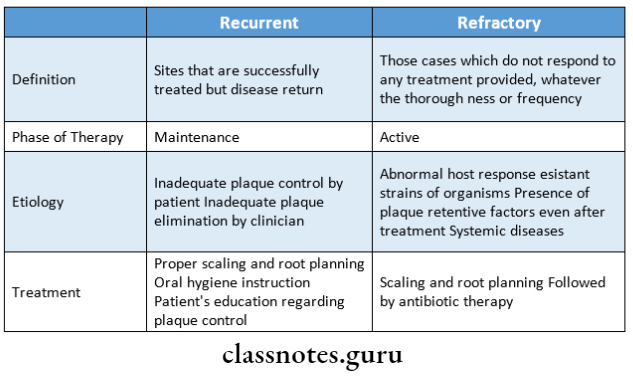Necrotizing Ulcerative Periodontitis Refractory Periodontitis Important Notes
AIDS-associated necrotizing ulcerative periodontitis Features:
- Severe soft tissue necrosis with rapid destruction of bone leading to its exposure
- Destruction may extend to the vestibular area and palate
- May result in necrotizing stomatitis
Read And Learn More: Periodontics Question and Answers
Necrotizing Ulcerative Periodontitis Refractory Periodontitis Short Essays
Question 1. Necrotizing ulcerative periodontitis (NUP).
Answer:
When ulcerative gingivitis extends deeper into the periodontal structures, it results in loss of attachment and bone loss
Necrotizing Ulcerative Periodontitis Types:
- AIDS-associated
- Non-AIDS type NUP
Necrotizing Ulcerative Periodontitis Clinical Features:
- Ulceration and necrosis of the gingival margin
- Presence of pseudo-membranous slough
- Pain
- Bleeding spontaneously
- Deep pockets
- Osseous craters, Gingival recession
Necrotizing Ulcerative Periodontitis General Features:
- Localized lymphadenopathy
- Fever
- Malaise
Question 2. Refractory Periodontitis.
Answer:
Refractory Periodontitis Definition:
- According to AAP, it is defined as those cases which do not respond to any treatment provided, whatever the thoroughness or frequency
Refractory Periodontitis Etiology:
- Abnormal host response
- Resistant strains of microorganisms
- Failure to treat plaque retentive factors Smoking
- Systemic diseases
- Micro-organisms
- B.forsythus, F.nucleatum, C.rectus
- S.intermedius, P.gingivalis
Refractory Periodontitis Clinical Features:
- Failure to restrict the progression of the disease
- No response of treatment on
- Plaque accumulation
- Attachment loss
- Persistent bleeding on probing
- Development of new areas of attachment loss
Refractory Periodontitis Treatment:
- Scaling and root planning
- Followed by antibiotic therapy
- Tetracycline 250 mg QID
- Amoxicillin 250 mg + 125 mg TID
- Clindamycin 150 mg QID for 1 week
- Metronidazole 400 mg TID
- Local drug delivery – gels, fibers, or chips
- Sub-antimicrobial dose of doxycycline SDD – 20 mg BID for 3 months
Question 3. Differentiate between Recurrent and Refractory Periodontitis.
Answer:

Question 4. Retrograde periodontitis.
Answer:
Periodontitis caused by pulpal infections that have entered the periodontal ligament either through the apical foramen or through lateral canals is termed retrograde periodontitis
Retrograde Periodontitis Pathways Of Communications
1. Pathways of developmental origin:
- Apical foramen
- Accessory canals and lateral canals
- Developmental grooves
- Enamel projections and pearls
2. Pathways of pathologic origin
- Tooth fracture
- Idiopathic resorption
- Loss of cementum
3. Pathways of iatrogenic origin
- Exposure of dentinal tubules following root planning
- Accidental lateral perforation during an endodontic procedure
- Root fracture due to endodontic procedure
Retrograde Periodontitis Pathogenesis:

Necrotizing Ulcerative Periodontitis Refractory Periodontitis Viva Voce
Cases that do not respond to therapy or recur soon after adequate treatment are referred to as refractory periodontitis
